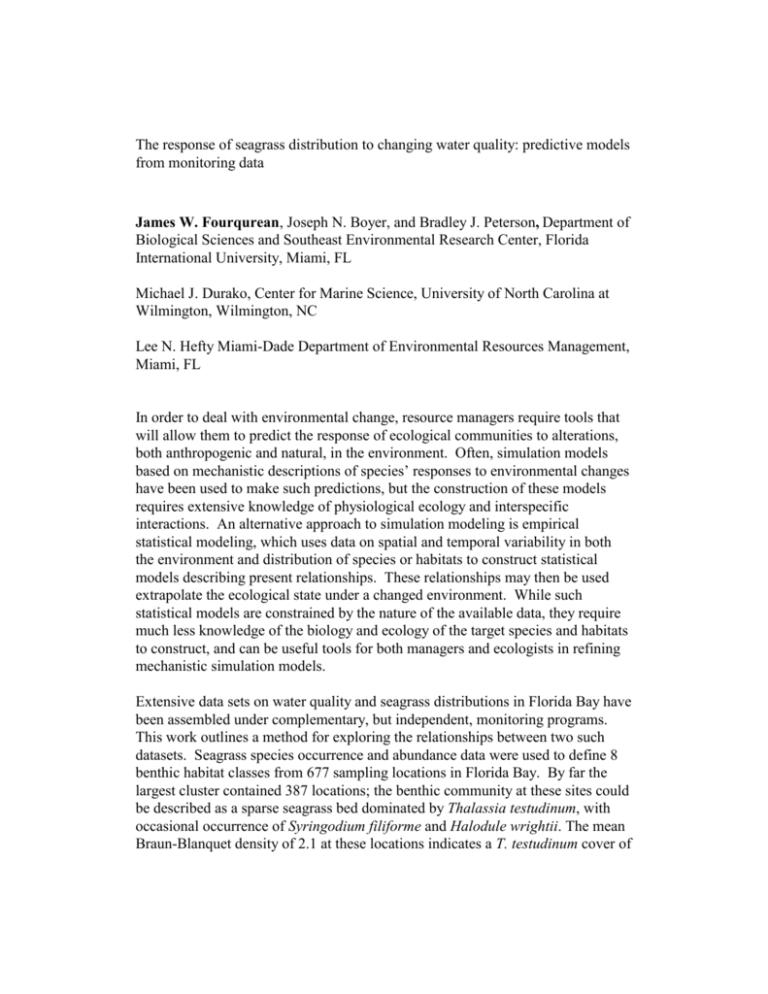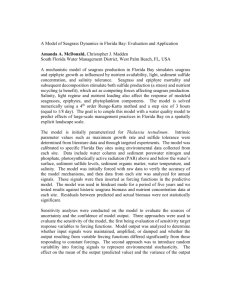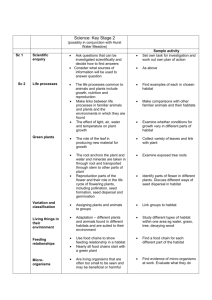The response of seagrass distribution to changing water quality
advertisement

The response of seagrass distribution to changing water quality: predictive models from monitoring data James W. Fourqurean, Joseph N. Boyer, and Bradley J. Peterson, Department of Biological Sciences and Southeast Environmental Research Center, Florida International University, Miami, FL Michael J. Durako, Center for Marine Science, University of North Carolina at Wilmington, Wilmington, NC Lee N. Hefty Miami-Dade Department of Environmental Resources Management, Miami, FL In order to deal with environmental change, resource managers require tools that will allow them to predict the response of ecological communities to alterations, both anthropogenic and natural, in the environment. Often, simulation models based on mechanistic descriptions of species’ responses to environmental changes have been used to make such predictions, but the construction of these models requires extensive knowledge of physiological ecology and interspecific interactions. An alternative approach to simulation modeling is empirical statistical modeling, which uses data on spatial and temporal variability in both the environment and distribution of species or habitats to construct statistical models describing present relationships. These relationships may then be used extrapolate the ecological state under a changed environment. While such statistical models are constrained by the nature of the available data, they require much less knowledge of the biology and ecology of the target species and habitats to construct, and can be useful tools for both managers and ecologists in refining mechanistic simulation models. Extensive data sets on water quality and seagrass distributions in Florida Bay have been assembled under complementary, but independent, monitoring programs. This work outlines a method for exploring the relationships between two such datasets. Seagrass species occurrence and abundance data were used to define 8 benthic habitat classes from 677 sampling locations in Florida Bay. By far the largest cluster contained 387 locations; the benthic community at these sites could be described as a sparse seagrass bed dominated by Thalassia testudinum, with occasional occurrence of Syringodium filiforme and Halodule wrightii. The mean Braun-Blanquet density of 2.1 at these locations indicates a T. testudinum cover of 1Notoseagrass 2 2sparse to 3 Thalassia 3dense to 4Thalassia 4Halodule to 6 bed dense 6 to 7Mixed species bed bed 7Syringodium to 8 8Halophila to 9 decipiens bed bed 9Ruppia-Halodule to 9.001 less than 25%, on average. The next-largest cover had 88 locations; these stations had a dense cover of T. testudinum (>75% cover) with some sparse S. filiforme and H. wrightii intermixed. Almost as common was a group of 85 stations dominated by sparse cover of H. wrightii with occasional T. testudinum. A group of 37 stations had a dense S. filiforme bed. At 19 locations, a dense mixedspecies assemblage was observed, with no clear dominant species. At 16 of the sites, Halophila decipiens was the dominant seagrass in the community, and at the remaining 20 sites, the benthic community was dominated by a mixture of Ruppia maritima and H. wrightii. Water quality data from 28 monitoring stations spread across the Bay were used to construct a discriminant function model that assigned a probability of a given benthic habitat class occurring for a given combination of water quality variables. A discriminant function model using only mean salinity of a site correctly classified only 13.9% of the benthic habitat stations, and adding salinity variability led to a small but statistically significant increase in predictive ability, as did stepwise additions of %Io and sediment depth. Adding the mean NO3-, TOC, NH4+ and TP as a group increased the accuracy of classification further, but adding information on the variability of these parameters did not increase the predictive ability of the model. The final discriminant function model correctly classified 56.7% of the benthic habitat stations, and the second-ranked predicted habitat classification was always biologically close to the actual habitat type . Not all benthic habitat classes were predicted with equal accuracy. The model was very successful in predicting the occurrence of Halophila decipiens (93.8% accuracy) and dense mixed species beds (84.2% accuracy), but was not successful in predicting the occurrence of benthic habitats with no seagrasses. For the sparse Thalassia, dense Thalassia, Halodule, Syringodium and Ruppia-Halodule communities, the most frequently-predicted habitat type corresponded to the actual habitat, and. For example, 66.1% of sparse Thalassia beds were correctly classified, but 16.8% were incorrectly classified as dense Thalassia beds. Very few mis-classifications were scored as H. decipiens beds or Ruppia-Halodule beds - two communities with very dissimilar habitat requirements The model predicted that the distribution of benthic habitat types in Florida Bay would likely change if water quality and water delivery were changed by human engineering of freshwater discharge from the Everglades. Probability of a Thalassia bed Under a hypothetical scenario Base case in which mean annual salinity was reduced by a factor of 2 kilometers and the variance in the salinity 0 1 2 3 4 5 was increased (CV increased by a factor of 2), the discriminant model predicts the southern expansion of the Probability of a Thalassia bed Ruppia-Halodule community Decreased salinity mean and increased variability into Florida Bay and a retreat of Thalassia-dominated communities away from sources of freshwater runoff. James Fourqurean, Southeast Environmental Research Center and Dept. Of Biology, Florida International University, Miami, FL, Phone: 305-348-4084, Fax: 305-348-4096, Jim.Fourqurean@fiu.edu, Question 4.











